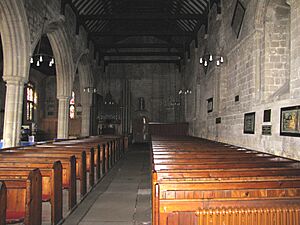Church of St Lawrence, Warkworth facts for kids
The Church of St Lawrence is a very old and important church. It stands in the village of Warkworth in Northumberland, England. This church is a special historic building because of its age and importance. It is dedicated to Saint Lawrence of Rome.
Contents
History of the Church
Early Beginnings
The First Churches in Warkworth
Imagine a church made of wood! The first church on this spot was built from wood way back in AD 737. It was given to the monks of Lindisfarne. Sadly, Viking raiders probably destroyed this wooden church in 875. But people didn't give up! A new church, made of stone, was built in the 9th and 10th centuries. We know this because its old foundations were found in 2008. Later, in 1120, King Henry I gave this church to his chaplain. Eventually, it became part of the Diocese of Carlisle.
Building the Current Church
The stone church you see today started being built in 1132. It wasn't just a place for worship. It was also a safe place for villagers when enemies attacked. Its walls were super thick, and the windows were tiny and high up to keep invaders out. But even with strong walls, danger could strike. On July 13, 1174, during a battle, Scottish soldiers attacked Warkworth. They set fire to the town. About 300 people who had hidden in the church sadly lost their lives.
Around the year 1200, a tower was added to the church. The belfry (where the bells are) and the spire (the pointy top) were added later, in the 14th century. In the 15th century, a south aisle and an entrance porch were built. Above the porch, there's a small room called a parvise. It was once used as a schoolroom before 1736.
In October 1715, Warkworth was the first town in England to support The Old Pretender as King during the Jacobite rising. His chaplain even held morning prayers in the church. In 1761, a famous preacher named John Wesley visited the church and gave a sermon. In 1860, the church had a big makeover. A new roof was put on, and some windows were removed. The old box-like pews were replaced with bench pews.
Recent Changes
After World War II, more changes happened. In 1947, some pews were removed from the south aisle, and the floor was relaid with Caithness stone. The churchyard also got a new drainage system. Trees were removed, and headstones were moved to the edges of the walls. The church's electricity, heating, and sound system have all been updated. In 1983, the church organ was repaired.
Fixing the North Wall
People knew the north wall of the church had been moving since the 13th century. It was built on shallow foundations near the River Coquet. In 2006, investigations showed the wall was leaning quite a bit and was in a dangerous state. This meant the church was put on a special list of "Buildings at Risk."
In March 2009, work began to make the wall safe and stable. They built two new buttresses (supports) that went deep into the ground, resting on 22-meter piles. This big project cost £300,000! Money came from English Heritage and from people raising funds. Once the work was finished, the church was taken off the "Buildings at Risk" list.
Church Features
Outside the Church
The church is built from squared stone. The main part of the church, the nave and chancel, has a roof made of Lakeland slate. The rest of the church has a leaded roof. The church clock you see today was put in place in 1875. It has a slate face with shiny gold numbers. Near an old door into the chancel, you can see three medieval stone coffins. These were found under the church floor.
Near the main gate, there's a special tomb. It belongs to Edward Dodsworth, who was a huntsman for King James. He died in 1630.
Inside the Church
The nave, which is the main part of the church, is very long – about 27.6 meters (90 feet)! It's the longest Norman nave in Northumberland. It has a special roof from the 19th century. The south aisle was built by the Percy family in the 15th century. Its east window has the only remaining pieces of medieval stained glass in the church.
The pulpit, where sermons are given, has five panels. Each panel features a work of art by Alfred Southwick. These include a picture of St Lawrence blessing the poor and one of St Hilda of Whitby. On the right side of the main door, you'll find the Knight's Tomb. It shows a stone image of a knight from the 14th century. He has his legs crossed and a shield with the coat of arms of the de Abulyn family.
Images for kids





